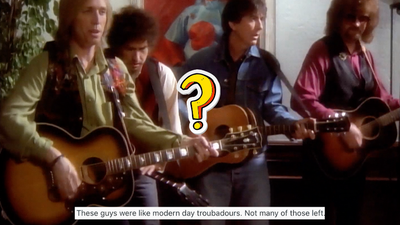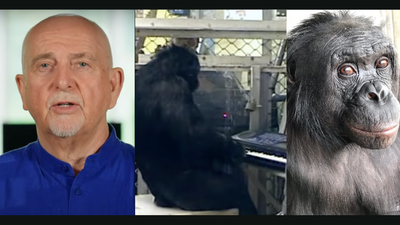Part eight in Walking in L.A., a GOOD miniseries by Ryan Bradley on transportation in Los Angeles and what it's like to get across the entire city on foot.
This is the part of the walk where I almost die, and it happens in the most unexpected and silly place. After visiting the underground transportation nerve center of Los Angeles, I head north (cheating briefly, by riding the Red Line subway) where I find Sunset Boulevard and spend the rest of the day working my way west towards Brentwood. The most interesting thing about Sunset isn't that its 22 storied miles wind through some of the ritziest zip-codes in Los Angeles (though they do), but how miserable it is to walk along.
Sunset is treacherous. The reasons for this are best described by Jan and Dean, who are not, in fact, transportation experts but a rock and roll duo from the 1960s. Their song "Dead Man's Curve" is about Sunset, specifically the section of Sunset immediately west of Beverly Hills. Jan and Dean are singing about a drag race along this strip. Over some excellent tire screeching and engine revving sounds, Jan sings in a high falsetto: "Won't come back from dead man's cuuuuuurve." Two years after the song became a hit, Jan bashed his head in and suffered brain damage after crashing his car along this same windy stretch of pavement.
Walking on Sunset is just as bad. If not for the driveway at 10350 Sunset I don't think I would have come back either. Along this stretch, the sidewalk gives way to dirt and then overgrowth so thick that walking along the shoulder becomes impossible. This means I have to cross the street—again and again. At first, darting out into oncoming traffic, playing a high-stakes game of Frogger, is kind of interesting. But then a BMW whips around a hairpin turn and I narrowly avoid death by diving back into the overgrowth. In that moment I realize two things. One: Maiming myself for the sake of this investigation feels incredibly dumb. Two: People love to drive.
The American dream is driving—particularly if it’s fast, through wide-open spaces. Driving is freedom. And this feeling of freedom? It makes people happy. Now, happiness is a vague, fuzzy thing but cars undoubtedly make a lot of people really happy. But only for a little while.
Pretend, for a moment, that happiness leads to well-being and long life. Actually, don’t pretend because the notion is real, although it’s only now taking hold. Transportation academics are just scratching the surface of what this means. Eric Morris—the UCLA doctoral student—is in the process of creating well-being surveys that will, as he puts it, "see how levels of access to various transportation modes relate to a host of life outcomes, including overall happiness." He's using all the new 2010 census data, and even studying the benefits of driving because, he says, "it enriches our lives to be able to travel so quickly and conveniently." Which is true, I guess, but I'd still much rather be mowed over by a walker on Dead Man's Curve.
Speed and convenience may not bring us meaningful happiness anyway. Consider the Seventh Day Adventists over in Loma Linda, about 70 miles from the ivy patch were I now sit. These are measurably happier, more fulfilled people who live much longer than most—six to ten years longer than the average American, in fact. Their longevity has been studied, their happiness quantified, and the research has proven that these folks do not drive so much. And at every Saturday, they go for a walk. You could say that it's a religious thing (which it is, kind of) but I see it more as a wellness thing. So does Dan Buettner, who finds long-living communities and sets out to discover what makes them tick. Buettner holds the Guinness World Record for distance biking, for a 15,500-mile ride from Alaska to Argentina, but his longevity studies are what he's famous for (Dr. Oz and Oprah are fans). What Buettner and his team of researchers do may sound as vague and fuzzy as happiness, but more and more scientists and scholars are taking note. Sure, you can't buy happiness or long-life, but you just might be able to engineer it.
The driveway at 10350 Sunset isn't particularly special, it's just the first driveway I come across after an extended, harrowing march along Sunset's sidewalk-less stretch. Here the houses are large and recessed and hidden behind high walls and iron gates. The house at 10350 is no exception—although the wall isn't all that tall. This whole day, through Beverly Hills and now Bel Air and later in Brentwood, I've felt unwelcome, constantly reminded that I am outside the home of someone who has gone to great lengths to keep me there. Are these people, shut away in their walled-off homes, happy? It's not a trite question, because another crucial factor when measuring happiness and long life is the importance of community, specifically your relationship to the people around you—your family, sure, but friends and neighbors too. Buettner calls this "belonging to the right tribe." So if your tribe happens to go walking regularly, chances are you will too, and you'll be happier and healthier and live longer for it.
It's evening when I cross the 405 freeway and I am limping. It's been a long day on a terrible stretch of road and I badly want to reach my destination. It's a place I know and love, the home where my father grew up and my grandparents still live. I turn off Sunset in the gloaming and they are there to greet me in the same home they have been in for more than 60 years. For a moment, I feel like time has stopped and death is still very near.
Next up:It began with a step and it ends with one too.
Photos by Ryan Bradley.












